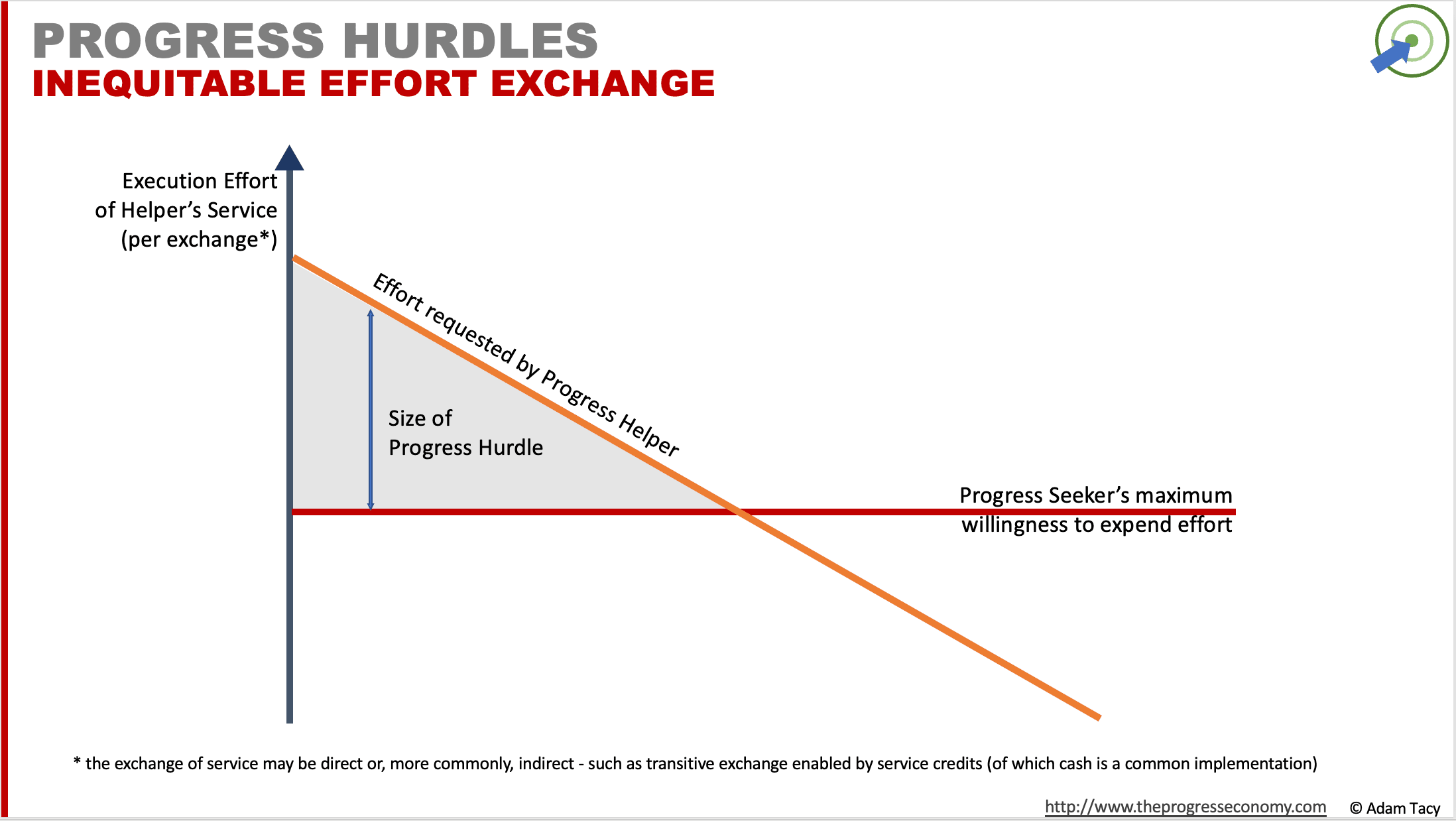THE IDEA
Since service is fundamental basis of exchange, helpers expect an equitable level of effort of service from the seeker in exchange for engaging their proposition.
A seeker feeling this level as too high is a hurdle to progress.
(note that service credits may replace direct exchange of service; in which case the level of effort must be given in service elsewhere but the seeker’s feeling of magnitude is still the same)
Progress hurdles
Just a quick recap of progress hurdles, they are:
progress hurdles – factors that if felt, uniquely and phenomenologically, by a progress seeker as too high, may lead them to decide to not start, or to abandon, a progress attempt.
Instead of viewing them as barriers, we refer to these factors as hurdles because seekers may choose to progress regardless of their size. A barrier would imply no progress attempts.
Editing below here
unbundling service, subscription, add-supported
Finally, we’ve reached our sixth progress hurdle. And, to put it simply, we’re talking about price. However, we must consider it in the context of service-dominant logic, which can make it appear more complicated. But it’s worthwhile understanding because it helps us explain and explore business model innovation.
Explore equitable service progress hurdle >>
The key take-away is that price signals the amount of effort a seeker needs to give elsewhere in terms of service.
The issue with price is it implies a value-in-exchange moment. A manufacturer embeds value in a product and sets the price of that. A consumer then hands over cash to the amount of the price. And in return gets the product with the embedded value.
In the progress economy, with it’s foundations on service-dominant logic, there is no value-in-exchange moment. For us, value relates to progress (potential and achieved). As such value is created as the activities in a proposition are executed (so caleed value-in-use). Price still exists though. But it can no longer represent a measure of value.
So what does price represent? Well to explain that we need to start with what service-dominant logic informs us
price, effort and service credits
To understand price we start with two fundamental premises of service dominant logic:
Service is the fundamental basis of exchange
Indirect exchange masks the fundamental basis of exchangeFoundational premises 1 and 2 of service dominant logic
These can be unpacked as follows. First, rather than exchanging cash for outputs, we always exchange services. To put another way, you do something for me, and I do something for you.
However, this exchange may not be so direct. Which we can explain like this: you work for a company which is really ou providing them a service. But you don’t really need the service they offer in return. What you want is service from an electric company, and entertainment companies, plus shopping services for food items and clothes etc. There is service exchange, it’s just not direct.
And, this indirect exchange may not happen at the same time. Additionally it may not be of the same magnitude. Your service to your employer, for example is of a different size to that which Netflix gives you.
The secret to greasing these different magnitude, different time, indirect exchanges is service credits.
Each proposition signals the number of service credits (price) it requires in order for a seeker to engage with it. And that indicates to a seeker how much effort they need to give in service elsewhere to gain the credits required for the service they want.
It just so happens that cash has been the most enduring implication of service credits to date.
understanding the hurdle
So this hurdle is about the seeker uniquely and phenomenologically determining that the effort of service they need to give elsewhere is low enough to engage the proposition.
And lowering this hurdle can be achieved in various ways. First the price is likely made up from the service credits requested by constituent elements of the entity/ecosystem. So, they could be replaced by elements that request less service credits.
We could also reduce the progress offered. That should reduce the effort required in the proposition. And therefore the service credits requested.
Alternatively we could look to business model innovation to reduce service credits required from seeker by replacing some/all from another entity -freemium, sponsored models, etc. Or to reduce the emotional magnitude through subscription or family sharing models etc.
And in larger propositions, handing over service credits may be tied to milestones of reaching certain amounts of progress.
considerations
Whilst the general intention would be to lower this hurdle to the minimum, we must appreciate we live in a capitalist world. Profit is not an ugly word. In our model it is simply additional service credits requested beyond those needed to be given to constituent elements of the proposition.
And number of service credits requested follows supply/demand models. Helpers will try to get as many as they can. Whilst seekers make the judgement if they are willing to give effort elsewhere to get the progress offered. If they are not, then they don’ engage with the proposition. And if enough do not engage either the helper needs to lower the hurdle or withdraw the proposition.
[]A price is a request for service credits. Where service credits enable the indirect nature of service exchange. As a result, price “becomes part of the value proposition” (Kowalkowski). In its service credit form, it is one of the hurdles to progress, opening our minds to business model innovations. Money, is simply regarded as the most successful, to date, form of service credit and has no intrinsic value.]
todo: is this useful, on paying = pain: https://smith.queensu.ca/insight/content/cash_is_the_king_of_pain.php ]

Let’s progress together through discussion…